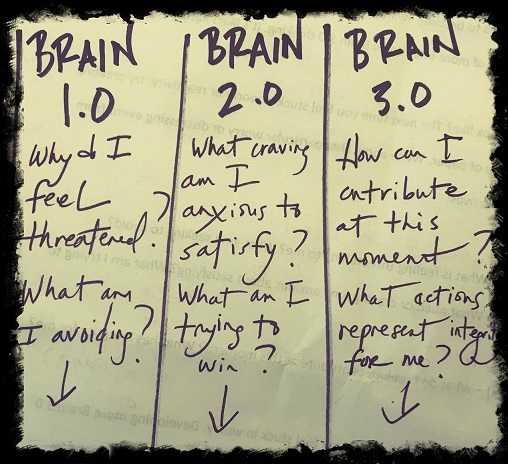I received a number of appreciative emails about my recent blog (on the ways we can calm unproductive anxiety about the future) and was inspired to share a tool that might prove useful when you find yourself in a downward spiral of unproductive worry.
The tool was developed by Due Quach (pronounced Zway Kwok), social entrepreneur and author of Calm Clarity: How to Use Science to Rewire Your Brain for Greater Wisdom, Fulfillment, and Joy. I’m not sure what Quach calls the “tool” but I call it “Our Three Brains”.
Quach says; when it comes to worries, we essentially have three different brains (or more accurately, three parts of our brain). Each “brain” plays a useful role, but we need to be mindful about which part is strongest – particularly when dealing with events that trigger worry.
Brain 1.0 is our Inner Godzilla. Godzilla is driven by fear and self-preservation – hyper-vigilant, thinking about worst case scenarios, always scanning for threats, and searching for escape routes. When Brain 1.0 is active and dominant, we tend to experience fear, anger, and what’s popularly known as a state of fight-or-flight. We feel stressed or anxious about protecting ourselves from a perceived or imagined threat. Our adrenaline system is activated!
Brain 2.0 is our inner Teen Wolf. The Teen Wolf is motivated by acquisition and reward. Neuroscientists connect this part of the brain with dopamine production. When Brain 2.0 is activated we expend energy searching out rewards we associate with accumulating happiness, success, and social status. Quach writes;
“When Brain 2.0 is triggered by a reward/carrot, we tend to feel a sense of anticipation, craving, emptiness or incompleteness, restlessness, like the grass is greener on the other side. Then if and when we get the reward we’ve been chasing, we feel high, like we are on top of the world. The problem is that the high doesn’t last and then we have to chase another reward to feel it again.”
So, the pursuit of goodies like status, power, and pleasure can produce a unique form of impulsiveness and anxiety. Indeed, our drive to win these rewards can lead good people to act selfishly, manipulatively, and even unethically.
Brain 3.0 is our Inner Sage. The Sage pursues self-mastery, meaning, and well-being. It is who we are when we are at our best – even when no one is watching – thoughtful, proactive, imaginative, compassionate, and altruistic. When we respond to an event or worry using Brain 3.0 we take action in the context of our larger purpose and highest principles.
In an increasingly uncertain and rapidly changing world it’s useful to notice how often Brains 1.0 and 2.0 dominate. When we become more aware of our “autopilot” defaults we can consciously begin to exercise the muscle of more intentional Brain 3.0 thinking. It’s like Pilates for the brain – repetition builds muscle.
So what does this exercise look like in practical terms? The next time you feel stuck in worry or reactivity, try the following “workout”;
Create three columns on a piece of paper and write about a particular worry or distressing event from the perspective of each Brain:
Brain 1.0 (column 1) – Why do I feel threatened? What am I avoiding?
Brain 2.0 (column 2) – What craving am I anxious to satisfy? What am I trying to win?
Brain 3.0 (column 3) – How can I contribute at this moment? What actions equal integrity for me?
The more we practice this exercise when we are anxious, worried, or stuck, the more we increase our capacity to transition quickly from a reactive state into the version of ourselves that is more grounded, clear, and resourceful. Developing Brain 3.0 muscle doesn’t mean we will eliminate moments in which we feel triggered, afraid, or impulsive. But as Quach writes: By tying our neural superhighways to Brain 3.0, we can shift from “mindless autopilot” to “conscious autopilot.”
For additional tools and the neuroscience behind these ideas, check out Due Quach’s article in Medium.
For a refresher on questions that can help activate “Brain 3.0”, revisit my September 23, 2021 blog post.
Image credit: M. Yoder

Thanks Larry – good stuff! Let me know when you’re in Colorado and available to help Kim and I discuss/plan our Foundation. Both of us look forward to your thoughts. Happy to host you at the farm!